Extracts from Minik Rosing's diary Newsletter 3
Dato 4.9.2006
Newsletter 3 from Galathea 3
25 August to 4 September 2006
The following comprises diary entries by Minik Rosing, expedition leader from Copenhagen to the Azores.
25 August 2006
Our departure (from Narsarsuaq) was delayed till 09.00 hours, as the Captain was given permission for ice-reconnaissance in Bredefjord and Narssaq Sund. This would indicate whether a seismic profile could be taken for the climate project’s purposes. It emerged that there is around 3/10 to 7/10 ice in both fjord and sound, so we have decided not to do seismic studies.
Researchers who were signed off and media representatives waved goodbye as VÆDDEREN left port, the Galathea song playing on her loudspeakers.
Transfer to Narssaq Sund, where the triangular dredge was used for Alien Matter project work. Meanwhile, Dutch expert Jack Schilling oversaw the rigging of piston-coring gear (used for retrieval of sediment samples for seismological data). We had picked Narssaq Sund for the first core collections as the weather was good. We could carry out the work in calm conditions, with good visibility. The piston corer is sent to the sea floor by means of the ship’s main cable, but it has first to be positioned at the ship’s side with a crane and an auxiliary winch before it can be fastened to the main cable.
This procedure was held up by a technical hitch with the auxiliary winch. The hydraulic oil in the winch was overheating, meaning that the drive went into neutral, discharging the entire wire which held the piston core. The instrument was lost in 270 metres of water. Later we concluded that the loss of the equipment was an unfortunate but manageable affair, brought about by an unforeseeable technical failure. Everyone involved was happy that no-one had been harmed during the incident. The ship’s routine safety measures were working, thanks among other things to the constant attention of the Executive Officer on the quarterdeck.

Photograph Minik Rosing
The piston corer being made ready for use. Shortly after this a technical fault resulted in the loss of the corer.
After this misfortune, everyone went to eat. The Captain, Executive Officer and I called a short meeting at 18.45 hours to explain what had happened and what would be the consequences for further research. A press briefing was held at 19.00 hours.
The press were informed of the nature of the accident. We were able to give a reassurance that the gravity core equipment on board would satisfy the needs of the research activities planned for leg 3 of the journey.
Even as the press briefing took place the gravity corer was being rigged up. Shortly after 20.00 hours the first lowering of the gravity corer took place at the chosen site.
This first test was successful, giving a sample of about 3 metres, so that only 3 hours after the loss of the piston corer, sediment from Narssaq Sund was hauled up. Further cores were collected during the course of the afternoon, filling six metres of pipes in all. So the day ended in success. The project “Changes in South Greenland’s climate and environment” had managed to achieve their high priority sampling.
It was late and the amount of ice in the Bredefjord meant that we decided not to make seismic recordings until the next day. Instead we would map an underwater canyon which bisects the continental shelf at 600 metre's depth along the Bredefjord. The mapping was done during the night using multibeam (an advanced echo sounder which maps the seabed three-dimensionally). Final tests and calibrations were made at the edge of the shelf. This took quite a lot of voyage time but meant that we would in future be able to use the multibeam fully. In order to calibrate the multibeam we had to take temperature readings throughout the water column. This would take place in the morning of 27 August using the CTD profiler (a machine for gathering samples in various containers which may be opened and closed successively, enabling sample collection at varying depths).
Thus, despite technical difficulties, the day was very profitable.
28 August 2006
It was declared Sunday – although it was unarguably Monday. Everyone who could postpone their duties slept in. The ship lay in unaccustomed stillness until late in the morning. Breakfast and lunch were combined into a brunch, which could not have been better. Eggs in every guise, sausages, bacon, pancakes, French toast, rundstykker (traditional rolls) pastries and other wonderful things decked the tables until 12.30. A light morning fog gradually burned off as the sun rose, revealing a smooth sea.
We sailed north until about 15.00 hours and carried out a CTD cast at around 2,000 metres depth, southwest of Nuuk. The water was the so-called ‘flower water’ which the Blom brothers use for their project ‘The DNA of the Polar Seas’. This took about 3 hours after which we carried on northwards aiming for a spot by the edge of the shelf, west of Sisimiut.
We reached this position at 5 a.m. on 29 August. Seismic measuring equipment was prepared and we embarked on an 80-mile long profile of the shelf-edge through to the Holsteinsborg Deep.
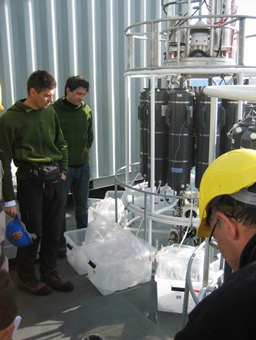
Photograph Minik Rosing
Nikolaj og Rasmus Blom decanting ’flower water' from the CTD profiler into bottles.
29 August 2006
We were busy with the seismic section along the Holsteinsborg Deep until half past two in the night. The profile is good and we will continue thus for the next 24 hours until all sections are complete. The plan is to call at Sisimiut on Sunday and hold an Open House in connection with the town’s 250 year Jubilee.
The weather is still calm and pleasant and everyone seems content with life on board.
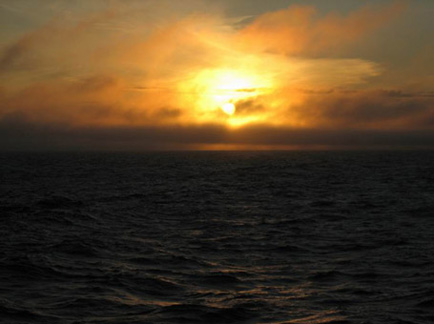
Photograph Minik Rosing
Sunset over the polar circle beyond Sisimiut.
2 September 2006
Seismic recordings continued along the Holsteinsborg Deep the whole night. We also got ready to take Brutalis cores (box cores) and gravity cores from a sedimentary basin within the Deep.
As expected there were suitable silts on the sea floor. We took several excellent samples. The mud was rich in organic matter and smelt strongly of hydrogen sulphide, which is produced by the bacteria living in it. Following the first sampling we moved to a new position and repeated the process. We did not get a chance to take samples of the early quaternary sediments which, judging by seismic evidence and Holger’s homework, should be present at the shelf-edge, but we are all happy with the core samples from more recent deposits.
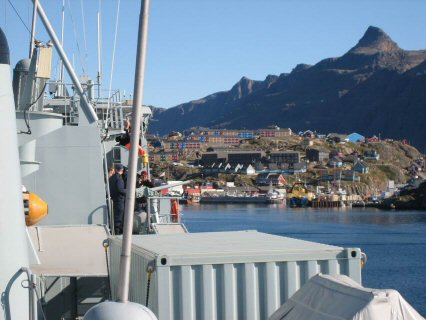
Photograph Minik Rosing
VÆDDEREN approaches Sisimiut
Our next activity was a scallop hunt with the triangular dredge on our way to Sisimiut. We found enough of them for Jan to use in the environment project. Jan sailed ahead in the MOB boat (man over board boat) setting traps, whilst the ship’s frogmen were catching crabs for his project. At 15.00 hours we passed the square in which Sisimiuts population was gathered to unveil a sculpture on the occasion of the town’s 250 year Jubilee. We gave a three-canon salute and sailed away to wait for Naja Arctica to put out so that we could dock. The weather has been fine all day, sunshine on board but with a large, ominous belt of clouds waiting out at sea. A visit to Sisimiut is planned in view of the forecast of a gale at sea.
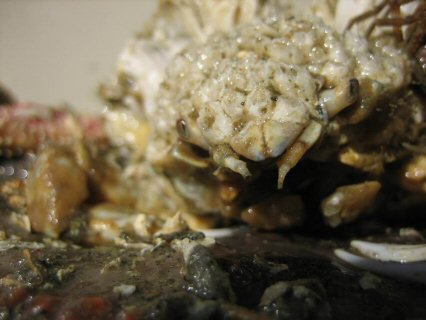
Photograph Minik Rosing
An armoured crab
The appearance of an increasing swell in the afternoon made us glad not to be at sea in the bad weather. The Mayor invited the Captain, Executive Officer and me to a lunch and local dance performance in the hall as part of the Jubilee celebrations. Just before 18.00 hours we heard that the Naja Arctica could not sail due to a minor problem with the engine – which was expected to be fixed by 10.00 the following morning. It was decided that the Executive Officer, Holger Lykke and I would go to the party as representatives of Galathea. We took the MOB boat together with one of the crew who has family in the town. The rest had to be content with a showing of "(The Good Ship) Martha" in the hangar, whilst Vædderen sailed back and dropped anchor at Amerloq.
The event was rather nice, the mayor giving a short speech about Galathea 3 and advertising our Open House on Sunday; he first asked ‘the professor’ (me) and thereafter Vædderens’s representative to stand to a round of applause. Somewhat overwhelming. Returning to VÆDDEREN in the MOB boat at midnight we witnessed the impressive fireworks above the town.
3 September 2006
All night we sailed the Amerloq fjord south of Sisimiut. We docked at 11.00 hours and welcomed Mayor Hermann Berthelsen on board for a cup of coffee. He presented a copy of Sisimiut’s Jubilee book to the ship.
At 11.30 hours, the commune had arranged an hour’s bus tour of the town for 38 expedition members, the Mayor acting as guide. This was a very kind gesture. Later the town’s football team met the ship’s team, resulting in a 3-1 defeat for Vædderen. Great fun for all.
16.15 -18.00 Open House on board. 967 happy Sisimiut dwellers visited VÆDDEREN, learning about the ship and the research work. Photographs were taken, children being held aloft and local radio and television broadcast programmes about the visit and the expedition itself. It was a great day, leaving no doubt that the Sisimiut visit had been beneficial, both for the crew’s wellbeing and as a presentation of the Galathea 3 expedition in Greenland.
4 September 2006
Departure from Sisimiut at 10.00 hours to the traditional playing of the Galathea song. Beyond the port the weather was black, rain over a slight sea. Because of this we decided to proceed to Amerloq fjord and use the time for multibeam and seismic measurements, as well as sampling.
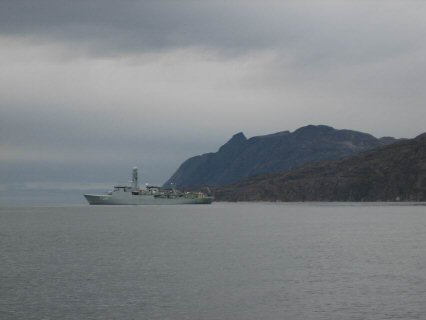
Photograph Minik Rosing
Waiting out the storm in Amerloq
The seismic monitor was engaged to select a 600 metre-deep sedimentary basin for a CTD cast, Brutalis and gravity cores. Weather in the fjord was lovely, practically calm, sunshine. All hands were firmly on deck – in deckchairs to be precise. We heard from the Dana, lying out to sea, that the wind speed had been 20 m/s (metres per second) and up to 35 m/s during the night. This made us especially glad to have been in Sisimiut for the Jubilee!

Photograph Minik Rosing
Samples from “Brutalis” or the box corer, which dredges upper layers of the seabed.
Sampling in Amerloq went well. The sediments were rich in organic matter with a visible release of methane from the cores. The cores are placed in transparent plastic tubing which is removed from the gravity core pipe as it is retrieved from the sea.
During the core and CTD profiling I took some press members to the small community of Safanguaq which lies at the extremity of the Amerloq fjord. About 100 people live there and I think it was quite an experience for the journalists and the two crew members to see a real settlement with sledge dogs and such activities as drying fish . Annette (from the Ministry of Education) and Emu enjoyed their visit to the kindergarten. Emu is the bird who shares the same name as the Ministry’s website: The Danish acronym EMU stands for ‘electronic forum for the world of education’.
Another core sample was taken on the way out of the fjord, from the outer basin. This was the first time quaternary geological investigations had taken place in Amerloq, so there was great satisfaction in seeing the results. We sailed round the mouth of the fjord deploying the multibeam; meanwhile, any loose objects were fastened down before the ship made out for the storm. We set sail for Nuuk fjord, where we expect to arrive tomorrow morning. A certain swell forced those who are not such good sailors to their cabins …
Follow Galathea 3 at Google Earth and see the week’s satellite pictures at www.satelliteeye.dk/index_uk.htm.
|